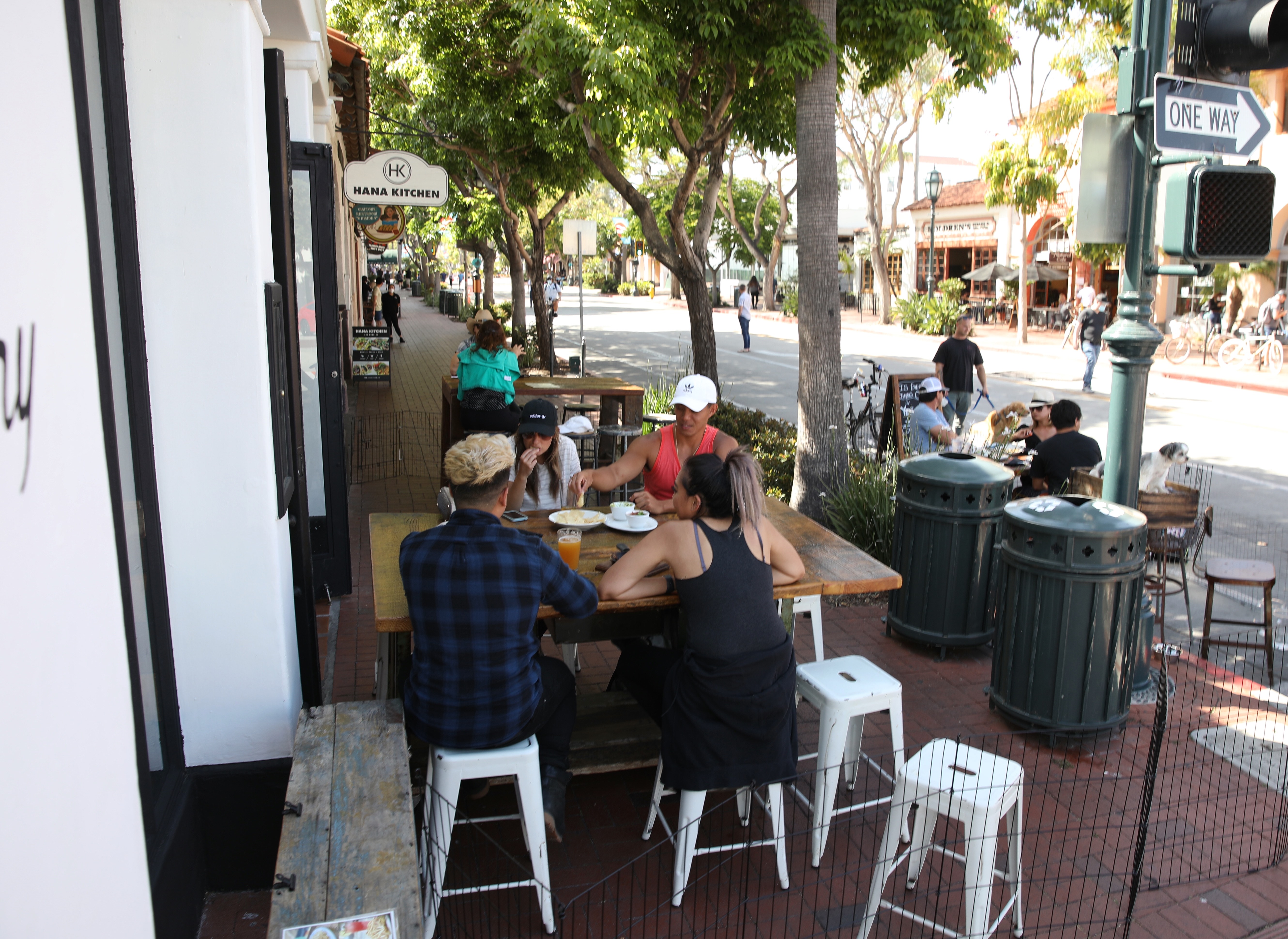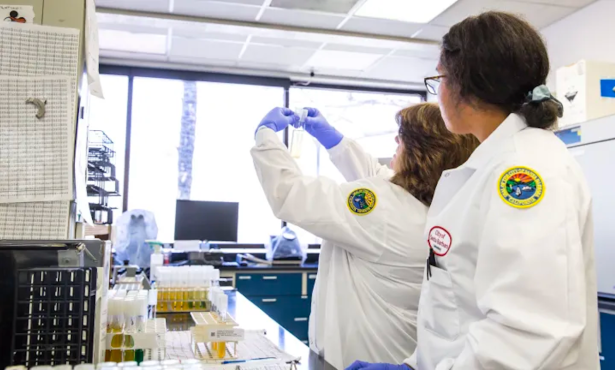Santa Barbara Lifts the Lid on COVID
Getting State Street Ready for Its Friday-Night Close-Up

A quietly expectant — perhaps even exuberant — buzz vibrated up and down State Street on Friday afternoon from Haley to Sola streets as walkers, gawkers, telephone talkers, and clusters of selfie-wielding friends took a pre-promenade stroll before the official — and historic — starting time of 4 p.m. when State Street opened up to pedestrians and closed off to traffic. It’s part of a desperate bid by City Hall, working in conjunction with downtown merchants, to jump-start the downtown’s desperately ailing economy.
Friday night marks the official start of what some in City Hall are branding as Operation Lift Up Santa Barbara, the first time in nine weeks that restaurants will be allowed to open their doors to customers both inside and out. City Hall — pushed by an ad hoc task force started by Mayor Cathy Murillo — is not merely allowing businesses to reopen but to expand operations out into public sidewalks. In the wings are expansions to public parking lots, city parking spaces, and even private parking lots. By doing so, the thinking is that it will create enough additional space so that restaurants can bring in enough customers to become economically viable while at the same time maintaining the six-foot social-distancing rule insisted upon by state and county public health officials.
Beyond that, there’s the element of fun — a sense of excitement and experience — designed to draw customers and residents back to a downtown that had long ago become a set for a Zombie Apocalypse rerun. How it all shakes out has yet to be seen; as everyone agrees, there’s simply no time for dress rehearsals. For a City Hall both famous and infamous for the grinding pace of its painstakingly deliberative process, the speed with which elected officials and city administrators have worked to reopen State Street has been nothing short of whiplash-inducing.
On Friday morning, City Administrator Paul Casey signed the emergency orders authorizing changes to what can and cannot happen, not just on State Street but everywhere within city limits. On Friday afternoon, City Administrator Assistant Nina Johnson and the city’s new economic development czar Jason Harris met on the 500 block of State Street with about 30 restaurant operators. The meeting, announced one hour before it began, was a discussion of the merits of sidewalk tables versus in-the-street dining, and wheelchair access, planter boxes, and accommodations to be made for emergency vehicles and delivery trucks. Most in attendance wore masks.

Earlier in the day, City Attorney Ariel Calonne acknowledged City Hall had, in fact, moved “extremely fast,” stressing that the effort had been all about teamwork. “We all learned from Alexander Haig,” the normally deadpan Calonne joked, referring to the one-time Secretary of State who famously proclaimed, “I’m in charge here,” just after then-President Ronald Reagan was shot and wounded by would-be assassin John Hinckley Jr. “It’s teamwork that matters, not individual accomplishment.”
The issue of alcohol, naturally, remains the fly in the ointment and one that’s buzzing loudly. It’s booze — wine, beer, and spirits — that have kept State Street alive during the pre-pandemic economic doldrums, and it is, of course, alcohol sales that provide the margin by which many downtown operators wither, thrive, or fail. But whether restaurant owners, wine-tasting rooms, and craft beer emporiums can sell alcoholic beverages on city streets, Calonne said, is a matter for the state’s Alcohol Beverage Control Board (ABC) to determine. Although the ABC has now issued five emergency orders to make such permits easier to obtain now, the state agency has a shortage of staff to process such applications. Their offices are also closed through the holiday weekend until Tuesday.
To help make that process easier, Anthony Wagner, who is quickly emerging as the functional equivalent of a Swiss Army knife at City Hall, is convening a virtual meeting next Wednesday morning at 10:30 for anyone seeking to submit the proper paperwork to the ABC. Wagner — who has served as Police Chief Lori Luhnow’s consigliere and departmental spokesperson — has recently been reassigned to the City Administrator’s office, where he is helping City Administrator Paul Casey with crisis communications and giving Mayor Cathy Murillo talking points on how to better deliver talking points. Wagner, for example, helped produce Murillo’s 12-minute mayoral address that she delivered from her desk in her City Hall offices earlier in the week.
To some in the downtown hospitality and restaurant industry, Wagner has been seen as the equivalent of the troll under the bridge when it’s come to getting special dispensations for special events in which alcohol has been involved. To the extent that’s been true, Wagner is now singing loudly from another hymnal. He said he will help anyone who wants it to fill out the ABC applications so that they don’t get bounced back, drive them down to the agency’s Ventura offices, and hand-deliver them on Thursday. If all goes well, Wagner said, they should have the approvals by next Friday. He estimated there could be as many 389 such applications.
“We’re going to ensure it’s not a free-for-all down there, but our job is to ensure that these businesses succeed in this tumultuous time,” Wagner stated. “We’re up against it. We don’t have the luxury of sitting around and thinking about it for two weeks.”
Former mayor Hal Conklin — now spearheading a leadership committee composed of downtown merchants and commercial property owners lobbying City Hall for a more expedited and less cumbersome design review process — is giving the current administration high marks for making big changes under tight deadlines. Conklin has been congenially outspoken in his criticisms of the city bureaucracy in recent months but said he was struck by the alacrity with which city officials have been responding to beefs by local merchants during the pandemic.
One property owner complained during a recent Zoom meeting that he couldn’t put tables in his outdoor patio because of some disagreements about the color of the umbrellas. The response from one high-ranking bureaucrat attending the meeting was, “‘Call me, and we’ll take care of it,’” said Conklin.

Conklin recalled a time not that long ago when Santa Barbarans were allowed to walk up and down State Street while nursing a drink from an open container. He recalled a large drunken fight breaking out in De la Guerra Plaza during the last day of Fiesta in 1980. When police showed up to quell the disturbance, members of the crowd began hurling beer bottles at the officers. The next Tuesday, the cops were in front of the City Council demanding a ban on sidewalk imbibing. They got it. “You used to be able to walk up and down State Street with a margarita,” Conklin recalled.
His broader point? To the extent liquor permits might prove problematic, the ABC is not the only culprit.
Not everyone is mollified. Jim Knell of the SIMA Corporation — one of the biggest commercial landlords and management companies in Santa Barbara — has dismissed City Hall’s gyration to reopen the economy as “too little, too late.” Knell has argued that the COVID infection rate never justified the drastic protective measures taken and that those measures remained in place far too long. Many businesses will never come back, he predicted. The governor’s Stage 1, he said, was akin to a “do not resuscitate the patient” order, while Stage 2 induced “vital organ failure” in the patient. Knell is considering a lawsuit against City Hall, charging that the council’s vote this Tuesday to extend eviction protections for both commercial and residential tenants qualifies as an unconstitutional taking of his property rights.
As Santa Barbarans have struggled to come to terms with jump-starting the economy, certain norms have gotten lost along the way. Key among them is Santa Barbara’s commitment to an open public process during which deliberations and decisions are conducted in full view with opportunities provided for everyone to chime in. The deliberations of the mayor’s special task force, for example, was not bound by the state’s normal open meeting laws. This was partly because it was not a task force created and authorized by the entire council itself, but just by the mayor. Likewise with the county’s lengthy report on reopening the economy that was passed by the Board of Supervisors this Tuesday and approved by the governor. That report arose out of 27 meetings conducted by 350 stakeholders, but none of those gatherings was bound by the state’s public meeting laws.
Even as the state’s death toll from COVID continues to climb, many counties — Santa Barbara included — have seen no new deaths in the past two weeks or very few. Although the number of cases in Santa Barbara continues to grow — now past 1,500 — a large percentage involves prisoners in the Lompoc penitentiary. Most of those from the community at large have already recovered. The need for hospital beds has remained low for more than two weeks, as has the demand for intensive-care-unit beds and ventilators. Local public health authorities report having more than enough masks, gowns, and gloves to last for the next two weeks and considerably more capacity to process COVID tests — 900 a day — than the existing demand.
Both county and city officials insist that if there’s a jump in cases or demand for additional hospital resources, they have the protocols in place to “tap the brakes.”
Otherwise, the City Council is scheduled to hold a special meeting next Thursday to ratify the emergency measures undertaken in their name by City Administrator Paul Casey. That edict expires June 2. In the meantime, Mayor Murillo is asking that people who gather outside wear face coverings.
At the Santa Barbara Independent, our staff continues to cover every aspect of the COVID-19 pandemic. Support the important work we do by making a



You must be logged in to post a comment.